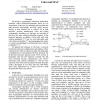Free Online Productivity Tools
i2Speak
i2Symbol
i2OCR
iTex2Img
iWeb2Print
iWeb2Shot
i2Type
iPdf2Split
iPdf2Merge
i2Bopomofo
i2Arabic
i2Style
i2Image
i2PDF
iLatex2Rtf
Sci2ools
FPGA
2004
ACM
2004
ACM
Divide and concatenate: a scalable hardware architecture for universal MAC
We present a cryptographic architecture optimization technique called divide-and-concatenate based on two observations: (i) the area of a multiplier and associated data path decreases exponentially and their speeds increase linearly as their operand size is reduced. (ii) in hash functions, message authentication codes and related cryptographic algorithms, two functions are equivalent if they have the same collision probability property. In the proposed approach we divide a 2w-bit data path (with collision probability 2-2w ) into two w-bit data paths (each with collision probability 2-w ) and concatenate their results to construct an equivalent 2w-bit data path (with a collision probability 2-2w ). We applied this technique on NH hash, a universal hash function that uses multiplications and additions. When compared to the 100% overhead associated with duplicating a straightforward 32-bit pipelined NH hash data path, the divide-and-concatenate approach yields a 94% increase in throughpu...
Collision Probability | Data Paths | FPGA 2004 | Hardware | NH Hash |
| Added | 01 Jul 2010 |
| Updated | 01 Jul 2010 |
| Type | Conference |
| Year | 2004 |
| Where | FPGA |
| Authors | Bo Yang, Ramesh Karri, David A. McGrew |
Comments (0)

